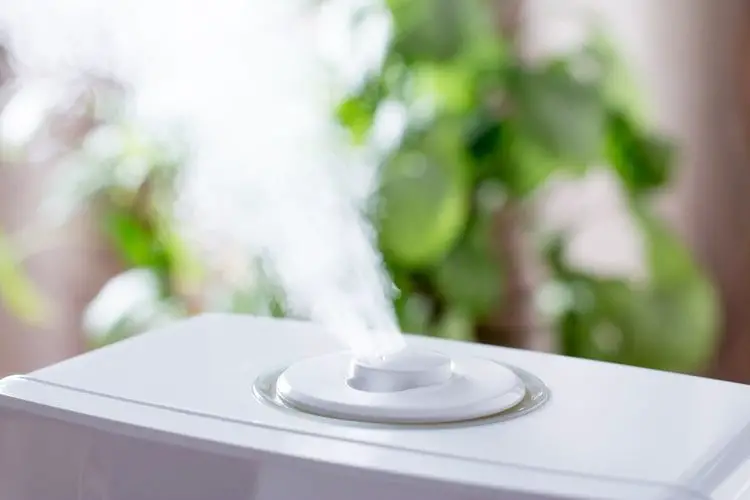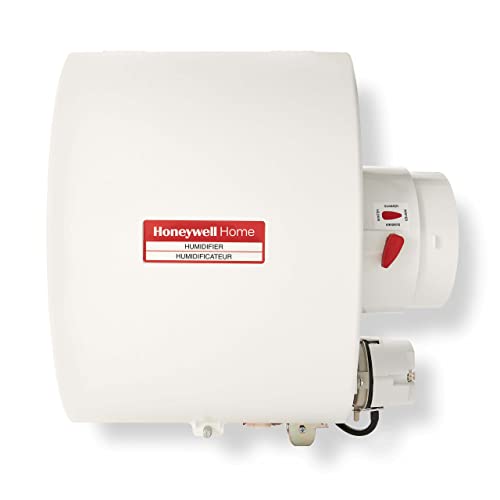Whole-house humidifiers keep indoor humidity levels at healthy, comfortable levels. For most people (and climates), that’s somewhere between 30 to 50 percent humidity. The right humidity levels can relieve irritated sinus passages, keep the skin moist, and reduce asthma symptoms.1 Whole-house units can tap directly into the HVAC or humidify a whole-house with a single humidifier. There are units big enough for most house sizes, including those over 4,000 square feet.
Our resident health expert for Healing Daily, INSERT NAME, helped determine the best whole-house humidifiers for our top 5 picks. The Aprilaire 600 Whole Home Humidifier rose to the top because of its dual-sensor system that adapts the indoor humidity levels in relation to outdoor temperatures and indoor relative humidity levels. The digital display and controls make it easy to set, adjust, and track humidity levels with a glance.
Whole-house humidifiers are just one way to keep your family healthy. Everything from the food and recipes you make to the home decor products you buy and the clothes you wear contributes to the health and safety of your home environment.
Our Health Expert’s Top 5 Whole-House Humidifiers
Here are the top picks from our health expert. You can compare the ratings and features of different models to find a good fit for your home.
| Editor’s Picks | Brand | Rating | Coverage Area | Humidifier Type | Control Type |
|---|---|---|---|---|---|
| Best Overall | Aprilaire 600 Whole Home Humidifier | 4,000 sq. ft. | By-Pass | Automatic | |
| Best Budget | Aprilaire 500MZ 500M Whole Home Humidifier | 3,000 sq. ft. | By-Pass | Manual | |
| Best Console-Style Humidifier | AIRCARE MA1201 | 3,600 sq. ft. | Evaporative | Automatic | |
| Best Wood Panel Humidifier | AIR H12-400HB 4-Speed Whole-House Humidifier | 2,500 sq. ft. | Evaporative | Automatic | |
| Best Water-Saving Humidifier | Honeywell Home HE280A2001 | 2,000 to 4,000 sq. ft. | By-Pass | Manual |
responsive=flip /]
*Ratings are on a scale of 1 to 5 and based on reviews, feedback, and opinions of actual customers.
[toc]
Who Should Buy a Whole-House Humidifier
- People with allergies – The appropriate humidity levels can help relieve the irritation, inflammation, and congestion caused by allergies. However, the humidifier must be properly cleaned and filters replaced to prevent mold from entering the breathable air and irritating allergies.
- Those who live in a dry climate – Dry climates pull the moisture from your skin, wood floors, and plants.2 A dry climate can exacerbate issues like dry eyes. A whole-house humidifier helps maintain a consistent, healthy humidity level.
- People with asthma – Dry weather can further irritate the air passages of those with asthma.3 While a humidifier won’t stop asthma, it can relieve the symptoms so those with allergies can breathe easier.
- People with sensitive skin – Dry climates and weather can irritate sensitive skin.4
Who Should Not Buy a Whole-House Humidifier
- People who live in wet climates – If you live where humidity levels are naturally high, you don’t need a whole-house humidifier. Too much humidity can be just as damaging as too little by contributing to mold or mildew growth.
- Those who aren’t willing to do the maintenance – Humidifiers do require regular maintenance, like adding water, cleaning the reservoir, and regularly changing the filter(s). Ignoring the humidifier when it needs maintenance can be more harmful than not having the humidifier at all because of the mold spores and other potential pollutants that can enter the air. Only undertake a humidifier if you’re on-board for regular maintenance.
Research Tips (from a Health Expert)
As a health expert, I often get asked about how to choose the right whole-house humidifier. Here are a few tips and best practices to consider as you’re deciding on one of these devices. As always, be sure to do adequate research of your own. Read reviews, check the features, and talk to friends, family, and coworkers who have a whole-house humidifier to get their recommendations.
- Coverage area – Humidifiers are designed to work within a specific square footage. For example, one that’s designed for a 1,000 square foot house won’t provide enough moisture for a 4,000 square foot house. Conversely, a large unit could overpower and saturate a small house.
- Installation ease – Some units can be installed by the homeowner, while others require a professional for proper installation. Check the humidifier’s warranty, too. Some may be void if you install the unit yourself.
- Humidifier type – Whole-house humidifier types include by-pass, steam, and evaporative (fan-powered). By-pass humidifiers connect to the furnace and pass warm air over a water tray to humidify it on its way to the rest of the house. By-pass humidifiers may or may not require a drain. Steam humidifiers boil water to create steam that’s then distributed through the house using the ventilation system. Some steam humidifiers require a drain, while others don’t because they reuse water. This type is the most efficient option, but it’s also the most expensive. Evaporative, sometimes called fan-powered, humidifiers connect to the furnace like a by-pass humidifier, except they have a fan that pushes air over the water tray, increasing the amount of humidity it can put out in a given amount of time. These humidifiers are more efficient than a typical by-pass design and can be installed in smaller spaces.
- Automatic versus manual humidity control – An automatic humidifier has a humidistat that controls the unit’s running time based on the readings of one or two outside sensors. This type of humidifier has the capability to adjust humidity to prevent creating condensation on windows as the outside temperature changes. A manual humidifier requires the homeowner to pay closer attention to the outside temperature and the humidity setting of the humidifier. For example, you would need to reduce the humidity levels in cold weather because the air can hold less moisture. Otherwise, you can end up with a damp house or damage to windows or wood furniture if the humidifier settings aren’t adjusted.
- Maintenance ease – All humidifiers will need some maintenance, such as cleaning the water tray or reservoir to prevent mold and mildew growth. At the change of seasons, you’ll need to open the humidifier and clean the components of mineral deposits that can clog the filter. Some designs are easier to clean and maintain than others. Evaporative humidifiers, for example, may have a wick that needs replacing fairly regularly. Consider how much time you’re willing to spend keeping the humidifier clean.
How Much Do They Cost?
Between $300 and $1,000
Most whole-house humidifiers cost between $100 and $1,000. That’s a fairly wide range, with steam humidifiers costing the most. Most evaporative and by-pass humidifiers fall in the $100 to $400 range. Humidifiers that cover less square footage and have manual humidity controls fall at the lower end of the price range, while larger coverage areas and automatic humidity controls cost more.
The Best Whole-House Humidifiers: Full Reviews
The Aprilaire 600 Whole Home Humidifier is a by-pass humidifier that connects directly to a home’s HVAC system and works for homes up to 4,000 square feet. It’s designed to put up to 17-gallons of water into the air every day. That helps it maintain 35 to 45 percent humidity. This model can be installed with the air return on either the right or left side of the furnace. It requires taking the humidifier apart, but each component can adjust to make sure that water drains out the bottom as it should.
A dual-sensor system and automatic humidistat keep the humidity at the selected levels. The sensors detect the outdoor temperature and indoor relative humidity to keep the home’s humidity at safe levels. A digital control panel and display show the humidity, power status, maintenance alerts, and blower activation type. The blower can be set to run continuously or only when the furnace turns on. Overall, this unit offers excellent control and installation versatility. The manufacturer recommends professional installation.
- Installs with a right or left side return
- Dual-sensor system—outside temperature and indoor relative humidity
- Automatic thermidistat control
- Requires a drain
- Warranty is valid only when installed by a certified professional
The Aprilaire 500MZ 500M Whole Home Humidifier has an impressive 3,000 square foot coverage area for a by-pass humidifier at this price. One reason for the low price is the manual humidistat control, which runs with a single sensor that keeps tabs on the indoor relative humidity. However, you’ll have to make manual adjustments when the outdoor temperature changes.
This Aprilaire puts up to 12 gallons of water into the home every day and has a compact design for smaller spaces. Like other Aprilaire humidifiers, it can be rotated to work with either a right or left-side return, offering versatile installation options. On the downside, it’s not the easiest unit to install, and the warranty is void if you don’t hire a professional to install it for you.
- Installs with a right or left side return
- Single sensor indicates indoor relative humidity
- Requires a drain
- Warranty is valid only when installed by a certified professional
The AIRCARE MA1201 is an evaporative humidifier on castors. Console-style humidifiers like this do not tap directly into the HVAC. Instead, they can be installed anywhere within your house. Casters provide convenient mobility so you can move the humidifier around the house to find the right placement. The evaporative wick, which actually looks similar to a filter, needs regular replacing. However, it’s not hard to take out or install, and it catches mineral deposits, so they don’t enter the breathable air.
The AIRCARE can humidify a space up to 3,600 square feet. You’ll need to regularly check, refill, and clean the tank throughout the cool months when the humidifier runs regularly. Four fan speeds let users adjust the humidity levels; however, once it reaches the set humidity or the reservoir runs dry, it automatically shuts off.
- Mobile unit with four casters
- Four fans speeds
- Auto shutoff
- Automatic shut off
- Does not use the HVAC
- Requires close access to an electrical outlet
- Loud operation
The AIR H12-400HB 4-Speed Whole-House Humidifier fades into the background with one of three faux wood panel exteriors. Many people appreciate a humidifier that doesn’t look like a humidifier, and this unit fits that description. It comes in a copper night, light oak, or oak burl exterior to fit within different design schemes. This unit doesn’t connect to the HVAC system but stands as a separate console in a central area of the house. The 12-gallon per day output can humidify a house up to 2,500 square feet.
The five-gallon tank refills using a hose and a kitchen or utility sink. An automatic humidistat uses sensors to track the indoor relative humidity and turns on and off to maintain the selected humidity level. Three fan settings let you adjust the output and the noise level to meet varying needs throughout the day.
- Three faux wood exterior choices
- Three fans speeds
- Automatic humidistat
- Automatic shut off
- Does not use the HVAC
- Requires close access to an electrical outlet
- Requires frequent refills
The Honeywell Home HE280A2001 features a water-saving, by-pass design and is easier than the average installation. This by-pass humidifier attaches to the warm air supply or return on the HVAC system. A unique PerfectFLO water distribution tray efficiently uses water, so there’s 33 percent less water waste than average. However, it does require having somewhere to drain water when it’s running.
Comparatively, the Honeywell has easier installation than most whole-house humidifiers. It has DIY potential, especially if you’ve done some DIY work before. Installation works on either the warm air supply or the return air duct of forced-air furnaces. A built-in humidistat regulates the unit and it works in homes of up to 3,000 square feet.
- Water-conserving system
- Relatively easy installation
- Humidity control isn’t precise
- By-pass shutoff may not completely close, letting air pass through when the unit is off
Frequently Asked Questions
Do whole-house humidifiers cause mold?
Whole-house humidifiers can cause mold in some situations. The most common is if the unit isn’t maintained properly. In these cases, the mold develops on the filter or water pan and blows throughout the house. Humidifiers can also leak into the furnace or other areas where mold can develop. The other possibility is if a model with an automatic humidistat should break, it’s possible for the unit to put too much humidity into the air. High humidity levels can encourage mold or mildew growth throughout the house. Regular maintenance and cleaning are vital to keeping the humidifier clean and effective.5
When should you use a whole-house humidifier?
Whole-house humidifiers can relieve dry skin, frequent nosebleeds, high static electricity, allergies, and asthma symptoms.6 The summer months aren’t usually a problem unless you live in a particularly dry climate. However, cold air holds less moisture than warm air, making the winter months problematic for many people. A whole-house humidifier can make winter more bearable and your skin more comfortable.
Where should you place a whole-house humidifier?
That depends on what type of humidifier you have. A by-pass unit attaches to the HVAC system, staying out of sight. However, a freestanding console model should be as centrally located as possible. Humidifiers aren’t exactly an attractive piece of equipment, and whole-house models tend to be large. Some units are disguised as other furniture types, while others look like a big piece of equipment. Try to find a place that’s out of the path of regular foot traffic but in an area that puts moisture where you need it most.
Should a humidifier run all night?
To maintain healthy humidity levels and prevent overworking the humidifier, it’s best to leave it on all night. If it’s turned off at night, the humidifier will have to work harder once it’s turned on again to get humidity levels back under control. However, if you’ll be gone for several days, it’s best to turn the unit off.
Article Sources
Healing Daily uses only high-quality sources, including peer-reviewed studies, to support the facts within our articles. Read our editorial process to learn more about how we fact-check and keep our content accurate, reliable, and trustworthy.
- Humidifiers and indoor allergies. aaaai.org. Published September 28, 2020. Accessed May 17, 2021.
- Engebretsen KA, Johansen JD, Kezic S, Linneberg A, THyssen JP. The effect of environmental humidity and temperature on skin barrier function and dermatitis. Journal of The European Academy of Dermatology and Venereology. 2015. doi: 10.1111/jdv.13301
- Wolkoff P. The mystery of dry indoor air—an overview. Environmental International. 2018; 121(2): pp. 1058-1065. doi: 10.1016/j.envint.2018.10.053.
- Silverberg JI, Lei D, Yousaf M, Jonmohamed SR, Vakharia PP, Chopra R, Chavda R, et al. Association of itch triggers with atopic dermatitis severity and course in adults. Annals of Allergy, Asthma & Immunology. 2020; 125(5): pp. 552-559. Published June 13, 2020. Accessed May 17, 2021.
- Mold course chapter 9: Prevention. epa.gov. Accessed May 17, 2021.
- Tunkel DE, Anne S, Payne SC, Ishman SL, Rosenfeld RM, Abramson PJ, Alikhaani JD, et al. Clinical practice guideline: Nosebleed (epistaxis). Otolaryngology—Head and Neck Surgery. 2020; 162(1): pp. S1-S38. doi: 10.1177/0194599819890327.








